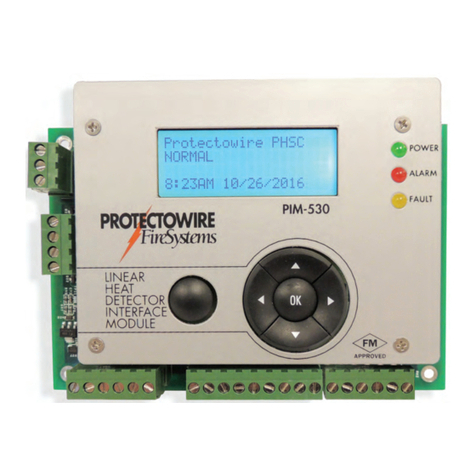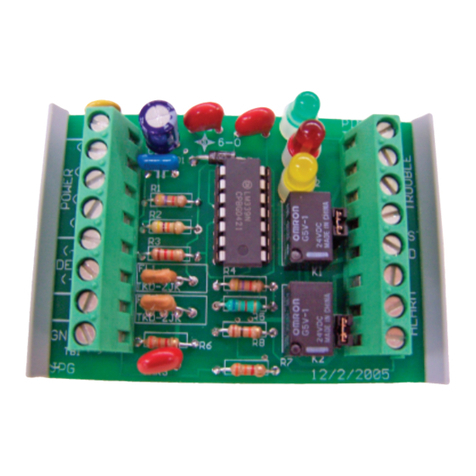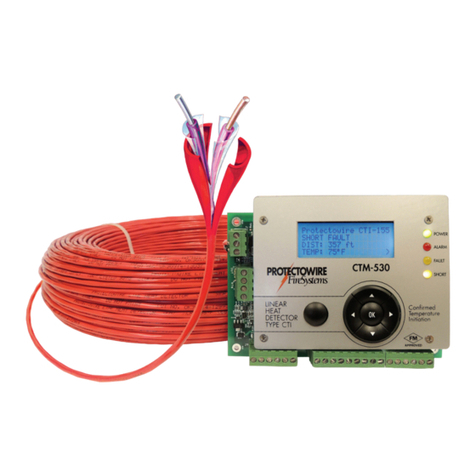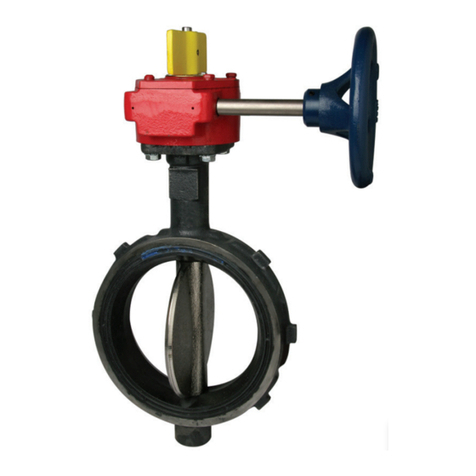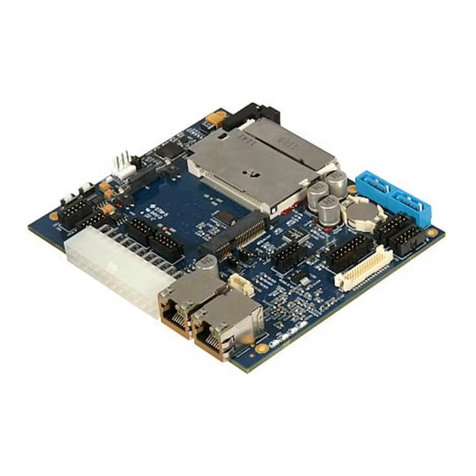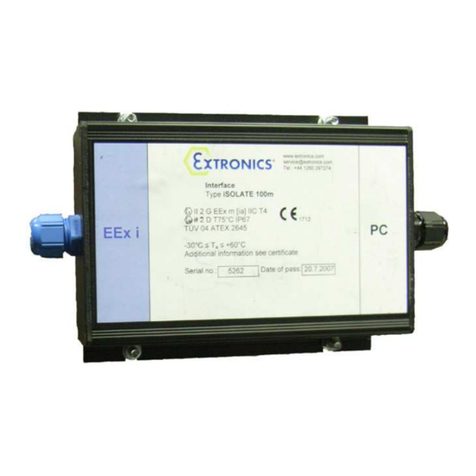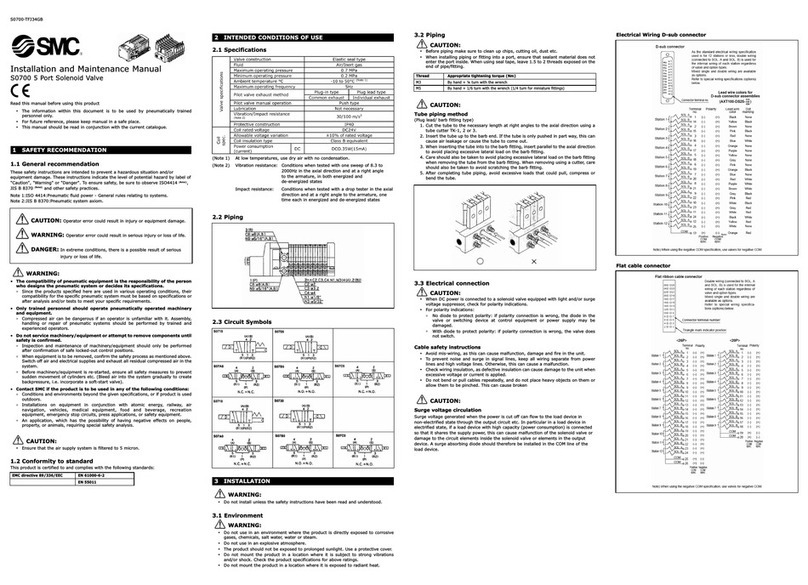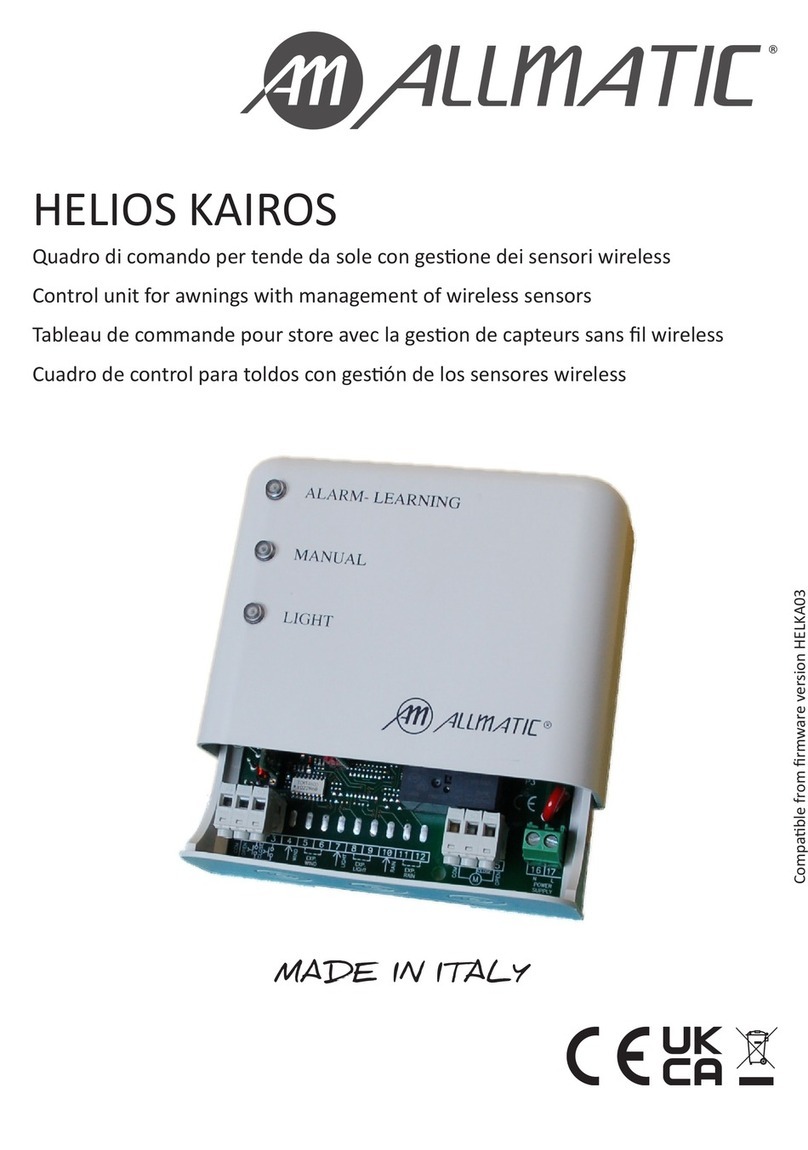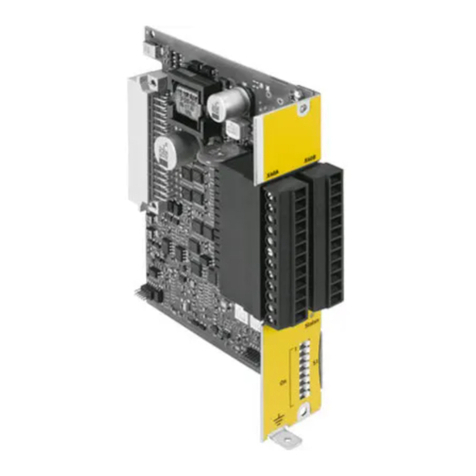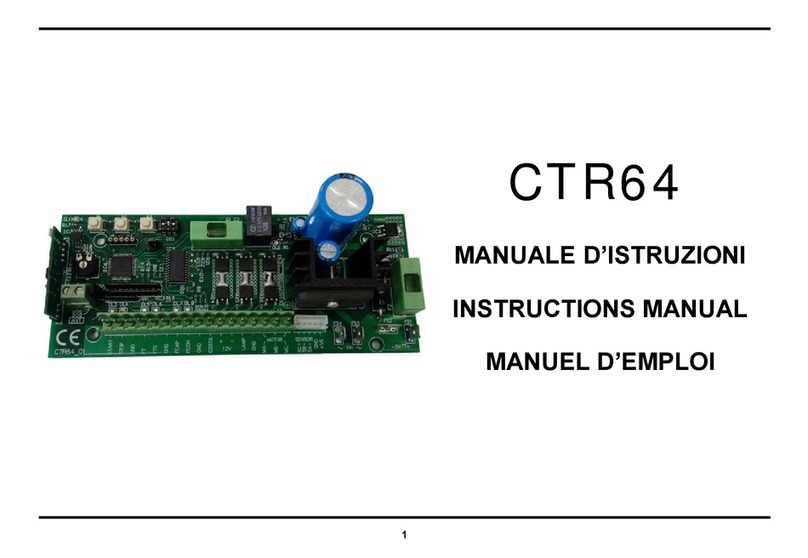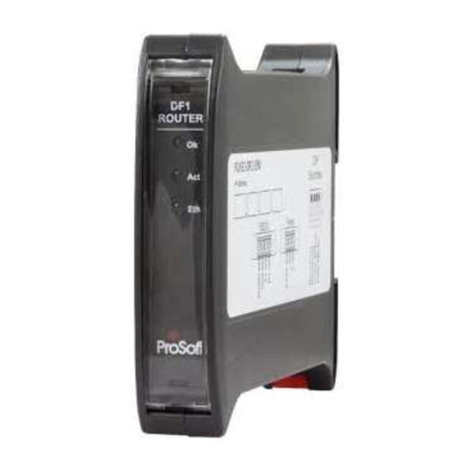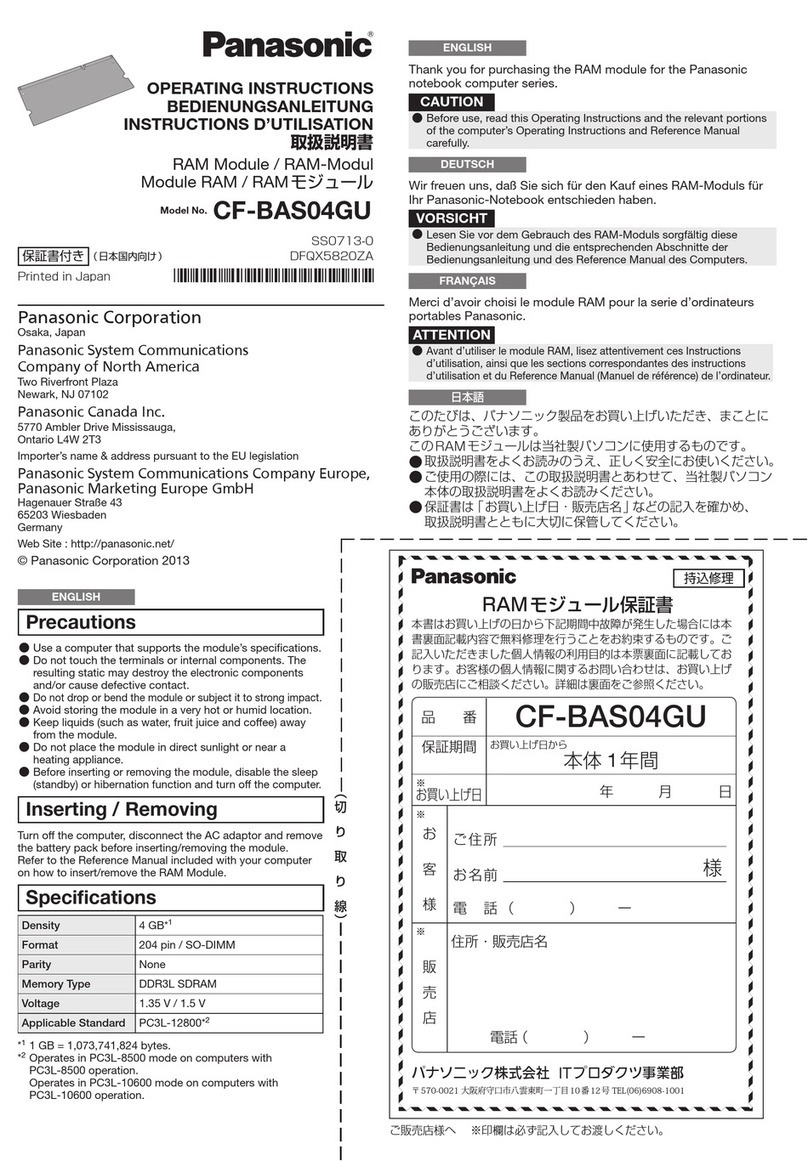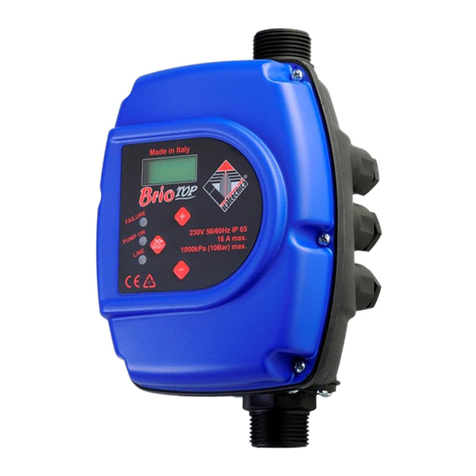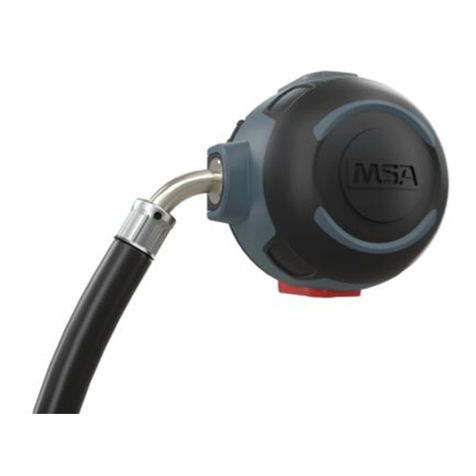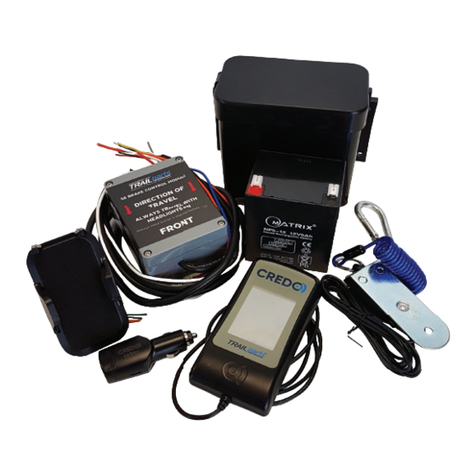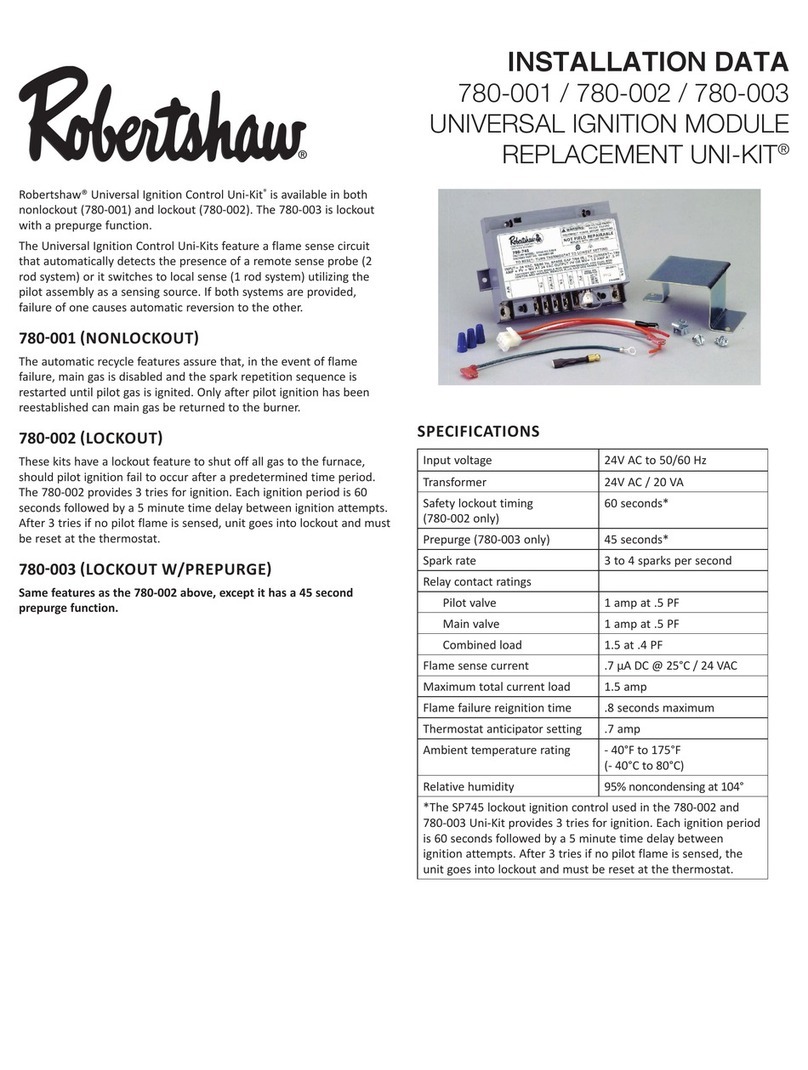Protectowire SRP4x4 User manual

STANDARD RELEASE PANEL
OPERATING & MAINTENANCE MANUAL
SRP4x4
An ISO 9001:2008 Registered Company
APPROVED

IMPORTANT SERVICE NOTICE
When requesting service assistance, or to order parts for this
control panel, you are required to provide the Model Number,
Drawing Number and Serial Number. This product information
is recorded on the Panel Identification Label located inside the
control panel. Please have this information available before call-
ing your Authorized Protectowire Distributor or the Factory.

1
Table of Contents
General Information & Panel Specification
Company Information / Publishing Date ............................................................................................ 2
Notice & Warnings............................................................................................................................... 3
System Description & Features............................................................................................................ 4
Systems Specifications..................................................................................................................... 5 - 6
Enclosure Information
Enclosure Dimensions...................................................................................................................... 7 - 9
Panel Mounting................................................................................................................................... 10
Battery Cabinet Mounting................................................................................................................... 11
Wiring
Wire Routing Detail (Power Limited vs Non-Power Limited).......................................................... 12
Wire Size Estimator............................................................................................................................ 13
Field Wiring (Initiating Device Circuits)........................................................................................... 14
Field Wiring (NAC & Solenoid Release Circuits)............................................................................ 15
Options
Alarm Point Location Meter (PDM-1000-4)...................................................................................... 16
Auxiliary Relay Module (RB-4)......................................................................................................... 17
Class A Alarm Notification Module (AM-91-2)................................................................................. 18
Installation / Troubleshooting
Installation Test & Maintenance.......................................................................................................... 19
Troubleshooting............................................................................................................................ 20 - 24
Programming
Wire Diagram Program Chart...................................................................................................... 25 - 39
Battery Calculations
Battery Size Selection Chart............................................................................................................... 40
Panel Instructions (tearout)................................................................................................................. 41
Appendix A
Listed Solenoids, Notification Appliance Devices, Listed Smoke Detectors.............................. 42 - 44

2
The Protectowire Co., Inc.
60 Washington Street, Pembroke, MA
U.S.A. 02359-1833
Telephone: 1-781-826-3878
Fax: 1-781-826-2045
WWW.PROTECTOWIRE.COM
Model SRP-4x4 Standard Release Panel
Operating & Maintenance Manual
Man-2002 Rev. C
Publish Date 08-04-2016

3
Notice
TESTING AND MAINTENANCE OF SYSTEM CONTROLS SHALL BE PERFORMED BY COMPETENT
PERSONNEL HAVING JURISDICTION OVER THIS PROTECTIVE SIGNALING SYSTEM.
TESTING ZONES WITH SOLENOID RELEASE CIRCUITS AND EQUIPMENT SHUTDOWN CONTACTS
MAY BE ACCOMPLISHED BY USE OF A JUMPER WIRE ACROSS EACH DETECTION / INITIATING CIR-
CUIT FIELD WIRING TERMINALS ONLY AFTER THE OUTPUT DISCONNECT SWITCH, LOCATED IN
THE LOWER LEFT CORNER OF MAIN BOARD, HAS BEEN PLACED IN THE LEFT POSITION. SLIDING
THIS SWITCH IN THE LEFT POSITION ALLOWS OUTPUT SIGNALS FOR OP2, OP3, AND OP4 TO BE
BYPASSED.
NOTE: IT IS ALWAYS GOOD PRACTICE TO DISCONNECT ALL PRE-ACTION SYSTEMS PRIOR TO
TESTING.
WARNING!
FATAL ELECTRICAL SHOCK AND EQUIPMENT
DAMAGE MAY RESULT FROM FAILURE TO REMOVE
ALL POWER PRIOR TO SERVICING SYSTEM.
CAUTION
The Protectowire Co., Inc. designs and manufactures fire protection systems to meet both UL and FM
Global criteria for electrical transients introduced on both the power supply side of the system and into the
panel from field wiring for initiating device circuits, notification appliance circuits, and other external field
routed wiring.
Fire protection systems located in areas subject to lightning strikes, or subject to other severe transients,
and electromagnetic interference, should be protected similar to computers and other electronic systems
with supplemental surge and filter protection both on the power supply side and on field wiring for initiat-
ing device circuits, notification appliance circuits and other field routed wiring.
Please refer to surge/filter manufacturers, (eg., DITEK 800-753-2345, www.ditekcorp.com) to specify
devices for your particular conditions. The National Lightning Safety Institute (www. LightningSafety.com)
also provides valuable information regarding the problems and solutions of providing lightning protection
including assuring true earth ground conditions.
Lightning strikes, other severe power surges, and significant EMI/RFI interference, by their nature, are
beyond normal design criteria and are outside the warrantee for manufacturing defects.

4
MODEL SRP-4x4
STANDARD RELEASE PANEL
System Description & Setup
The Model SRP-4x4 is a Fire Alarm Control/Releasing Panel which is FM approved, UL Inc. Listed. It is designed
primarily for use as a releasing panel for Pre-action and Deluge, water based extinguishing systems. This unit is in
compliance with NFPA-13, NFPA-72, and UL864 and can be used as a stand alone Fire Control Panel.
The Fire Control Panel is programmable by way of three (3) eight (8) position DIP switches. Select a system pro-
gramming scheme that meets your requirements as depicted on pages 25 thru 39. Special attention must be taken
in positioning dip switches for proper panel operation.
System Features
Four (4) Supervised Class A (style D) or Class B (style A or B) Initiating device circuits which may be configured
for the following functions.
1. Standard Initiating Device Circuits Compatible with the following:
a. Up to 10,000 Feet (3,048m) of Protectowire type PHSC linear heat detector.
b. Up to 5 (0.045mA) Hochiki smoke detectors.
c. Any combination of Normally Open contact initiating devices.
Examples: Conventional Manual Pull Stations, Waterflow Switches, Conventional Spot heat
detectors.
2. Supervisory Initiating Device Circuits Compatible with the following:
a. Any combination of Normally Open contact initiating devices.
Examples: Low air pressure switches, Valve Tamper Switches.
Four (4) Supervised Class B (Style Y) Output Zones: Each Output can be set up for any of the
following:
1) Notification Appliance Circuit (Output #1 thru #4)
2) Release circuit (Outputs #2, 3, and/or 4)
3) Supervisory Bell circuit (Outputs #3 & 4 only)
4) Trouble Bell circuit (Output #4 only)
- Releasing Zones can be set up for either single or cross zone operation
- All circuits are inherently Power-Limited per NFPA 70 (nec) see 760
- Initiating circuits can be wired as Class A or B
- Output circuits # 2, 3, and 4 have disable feature
- Signal Silence Button (common alarm and/or trouble conditions)
- System Reset Button
- Built-in Trouble/Supervisory Buzzer
- Auxiliary Contacts for Alarm/Trouble/Supervisory
- On Board 24V Auxiliary Power (100mA MAX) Resettable
- Ground Fault Detection (2.2K ohms to Ground)
- Battery Trouble circuit (low battery, battery overcharge, battery disconnect)
- 24 or 90 hour Battery Standby operation available Options:
1) AM-91-2 Module: converts Class B Notification Appliance circuit to Class A
2) PDM-1000-4 Protectowire Digital Alarm Point Location Meter.
3) RB-4 Auxiliary Alarm Relays

5
SPECIFICATIONS
Housing
Type: 16 gauge steel.
Door: Piano Hinged, lockable.
Dimensions: 20 1/2” x 14 1/4” x 4 3/4”
Finish: Red enamel with red, black and white logo/label.
Knockouts: Minimum of one 1/2” and two 3/4” knockouts on each side, top and bottom.
Visual Indicators
(Visible LED’s with door closed)
AC-ON: (1) Green
System Silence, System Trouble, Ground Fault Detection, Battery Trouble, and Output
Disconnect Supervisory: (5) Yellow
Common Alarm: (1) Red
Supervisory Zone Alarm: (1) Yellow
Input and Output Zone Trouble: (9) Yellow
Input and Output Zone Alarm: (8) Red
Control Buttons
Signal Silence: Momentary - Silences alarm signaling circuits, trouble buzzer and outputs
programmed as supervisory bell or trouble bell.
System Reset: Momentary - Resets all alarm circuits if condition has been corrected.
Removes power from initiating circuits.
Initiating Device Circuits (4 TOTAL)
4 NFPA Style D (Class A) or Style B (Class B)
Power-limited
IDC loop current (IDC): 0.3 mA.
IDC alarm trip current: 6.0 mA minimum.
IDC alarm current (short circuit): 44 mA max.
Normal loop voltage: 23 VDC
Linear heat detector resistance: 2000 ohms max.
Maximum Impedance to insure Alarm: 2.4K ohms.
End of Line Resistor: ELR-8.2K (Required in Class B configuration only)
Two Wire Detector capacity (per zone): 5 - 0.045 mA type Hochiki smoke detectors
Low/Disconnected Battery
Battery and system trouble indication when voltage falls out of range between 21 -29 Volts, or
has been disconnected
Fused battery and reverse polarity protection is provided.
Conditioning Resistor: 2.2 K ohm (Remove and replace with batteries)

6
SPECIFICATIONS (continued)
Output Circuit (4 TOTAL)
(ALARM INDICATING, RELEASING, SUPERVISORY AND TROUBLE BELL)
4 Supervised Notification Appliance Circuits (NAC) Class B, reverses polarity on alarm
(Optional Class A Module: AM-91-2). Maximum line loss not to exceed 1.0 Volts or 1 Ohm fully loaded.
Power-limited, each circuit has self-resetting type fuse (PTC).
Output #1; Dedicated for Notification Only; rated 24V FWR regulated, 1 amp continuous.
Outputs #2, 3 & 4 rated 24VDC regulated, 1 amp each, 2.1 amps combined for Solenoid activation.
Per UL listings circuits are rated .25 amps each, .75 amps combined for Notification Devices
Standby terminal voltage approximately -2.7VDC.
End of Line Resistor ELR-8.2K ohms.
Compatible Solenoids: FM Solenoid Groups A, B, D, E, F, G, I, J & K
For UL see Appendix A for compatible Solenoids.
Supervisory Circuit (1 TOTAL)
Supervisory monitors the following:
High/Low Air
Tamper/Valve positioning and etal
One latching Class B Supervised Initiating Device Circuit.
Power-limited.
End of Line Resistor ELR-8.2K ohms.
Circuit loop resistance 100 ohms.
Increase in circuit resistance causes supervisory trouble and system trouble.
Maximum resistance for supervisory signal 2200 ohms to insure alarm.
Minimum current 4.5 mA to insure alarm (10 mA short circuit maximum).
Normal supervisory standby loop current 2 mA.
Normal standby loop voltage 19.5VDC.
Input Power
120VAC - 1.37 Amp max. (50-60 Hz) or 240VAC - .85 Amp max. (50-60 Hz)
Green AC-ON LED goes off with AC power loss, causes system trouble and buzzer to sound.
System on battery backup.
System Trouble is also generated if voltage drops below 102V under alarm load, system is
transferred to battery backup.
Power Requirements
Standby - 160 mA @ 24VDC, 7.0 AMP Batteries for 24 hour standby
- 160mA @ 24VDC, 18.0 AMP Batteries for 90 hour standby (FM Requirement)
Alarm - 3.5 AMP MAX. @ 24VDC All Zones.
Battery Charger Specifications: 27 VDC @ 1.2mA trickle; 1 Amp fast charge.
33 AH Battery maximum, sealed rechargeable type.
Outputs
System Remote Signaling Relay contacts rated 3A, 30VDC (resistive) for Alarm, Supervisory & Trouble.
Auxiliary Power - 24VDC regulated. Rated 100mA max. Power-limited. (Resettable)

7
FRONT VIEW BACK VIEW
20.12 20.12
13.06
1.75
12.00
14.12
Ø0.62
1.06
Ø0.28
Ø0.28
14.12
9.87
1.06
0.60
IMPORTANT: The stated dimensions are for the enclosure back box only and do not
account for the overall dimensions of the enclosure with the door installed. To account
for the enclosure door and hinges add an additional 0.4” to the back box width, and
0.08” to the depth.
Caution: Do not drill through the top of the enclosure for conduit entry. Metal filings
will damage system components and voids factory warranty. Use knockouts provided
and seal all conduit openings to prevent water ingress.
ENCLOSURE DIMENSIONS

8
ENCLOSURE DIMENSIONS
IMPORTANT: The stated dimensions are for the enclosure back box only and do not account for the overall dimen-
sions of the enclosure with the door installed. To account for the enclosure door and hinges add an additional 0.4” to the
back box width & height, and 0.08” to the depth.
Caution: Do not drill through the top of the enclosure for conduit entry. Metal filings will damage system com-
ponents and voids factory warranty. Use knockouts provided and seal all conduit openings to prevent water
ingress.
TOP/BOTTOM VIEW
KNOCKOUTS
LEFT/RIGHT SIDE VIEW
3.5
1.5
1.5
20.12
1.5
1.5
1.1
4.5
3.0
1.5
3.0
4.5
1.0
0.88
1.1
0.88
7.5
0.88
1.1
4.62

9
ENCLOSURE DIMENSIONS
0.6
4
14.40
20.40
DOOR FRONT/SIDE VIEW

10
‘
0.28
‘‘
0
‘
.28
.62
.28
9.81
0.60 1.0
ALARM
SILENCE
BATT TRO
TROUBLE
SYSTEM
OUTPUT
4
GND FLT
AC ON
OUTPUT
OUTPUT
2
3
TROUBLE
GENERAL
1
SUPVRY.
ZONE
ALARM TROUBLE
4
ZONE
ZONE
ZONE
ALARM
2
3
TROUBLE
1
PANEL
FIRE
CONTROL
COM ALARM
OUT. DISC.
SUPVISRY
PANEL MOUNTING
- Panel shall be located in a clean, dry,
vibration free environment. Panel shall not be
subjected to extreme temperatures or humidity.
- Panel shall be wall mounted only, with the
top of enclosure at a height of 6 feet. Secure
the panel using the mounting holes provided.
- The panel must be easily accessible for main-
tenance with no physical obstructions blocking
it’s access or visual operation.
- The panels hinged door requires an additional
16 inches of free space. This additional space
allows the front door to be fully swung open.
- Do not drill through the top of the enclosure
for conduit entry. Metal filings will damage
system components and voids factory warranty.
Use knockouts provided and seal all conduit
openings to prevent water ingress.
- Once panel has been mounted connect all
required conduit, field wiring, detection
circuits, audible devices and/or solenoid valves.
Lastly connect input and battery back-up
power.
- Follow the Installation, Testing and
Maintenace procedure for complete testing
and operations of installed system.

11
BATTERY CABINET MOUNTING
- The Battery Cabinet should be mounted directly below
the SRP-4x4 Panel. The Battery wiring is classified as Non-
Power-Limited. Therefore the wiring must be segregated
from Power-Limited wiring with a minimum of two cable
entry openings and a 1/4” spacing between the two
conductors.
- Batteries are connected to the Fire Control Panel by using
16 AWG wire to the supplied PWSC splicing connector
(501740) and passed thru closed nipple rigid metal conduit.
- Battery wire leads should be color coded with respect to
supplied battery wiring of the panel.
Caution: Always observe polarity when connecting up
batteries. Improper connection will cause the battery
fuse to blow. See Page 41 for proper Battery Calculation
Sizing.
Caution: Batteries contain sulfuric acid which can cause
severe burns to the skin and eyes. If contact is made
with sulfuric acid, immediately flush skin or eyes with
water for 15 minutes and seek immediate medical
attention.
PWSC SPLICING CONNECTOR
PWSC SPLICING CONNECTOR
SRP-4X4 FIRE CONTROL PANEL
SRP-4X4 FIRE CONTROL PANEL
(501740)
(501740)
BLACK
BLACK
RED
RED
BLACK 16 AWG WIRE
BLACK 16 AWG WIRE
12 VOLT BATTERY
12 VOLT BATTERY
12 VOLT BATTERY
12 VOLT BATTERY
RED 16 AWG WIRE
RED 16 AWG WIRE
BLACK 16 AWG WIRE
BLACK 16 AWG WIRE
CLOSED NIPPLE CONDUIT CONNECTOR
CLOSED NIPPLE CONDUIT CONNECTOR
(BATTERY CABINET E-.5)
(BATTERY CABINET E-.5)
+
+
+
+
-
-
-
-
CIRCUIT
BREAKER
WARNING
HIGH VOLTAGE
110-120V
ALARM
ALARM
OUTPUT CIRCUITS
OUTPUT CIRCUITS
BATT TRO
BATT TRO
OUTPUT
OUTPUT
4
4
GND FLT
GND FLT
AC ON
AC ON
OUTPUT
OUTPUT
OUTPUT
OUTPUT
2
2
3
3
TROUBLE
TROUBLE
GENERAL
GENERAL
1
1
ZONE
ZONE
4
4
ZONE
ZONE
ZONE
ZONE
ZONE
ZONE
ALARM
ALARM
2
2
3
3
TROUBLE
TROUBLE
1
1
PANEL
FIRE
CONTROL
1
1
SUPVRY.
SUPVRY.
3
3
INPUT ZONES
INPUT ZONES
2
2
4
4
TROUBLE
TROUBLE
SILENCE
SILENCE
SYSTEM
SYSTEM
TROUBLE
TROUBLE
ALARM
ALARM
SUPVRY
SUPVRY
COM ALARM
COM ALARM
OUT. DISC.
OUT. DISC.
SUPVISRY
SUPVISRY
CAUTION
DE-ENERGIZE
UNIT PRIOR
TO
SERVICING
REMOVE
REMOVE
DISPLAY
DISPLAY
PLATE
PLATE
FOR
FOR
PROGRAMMING
PROGRAMMING
ACCESS
ACCESS
-+ OP1 OP2
+ - OP3
+-
OP4
+-
+24V -COM NO NC
TROUBLE ALARM
NOCOM NC
SUPERVISORY
COM NO NC SRP-4x4
PUSH TO READ ALARM POINT
GN L
ZONE 1 2 3 4
+- -
ZONE 2
+
ZONE 3
-+
ZONE 4
+-
SUPERV.
+-
RTN +
L OUT
PT 1 PT 2 PT 3 PT 4
GND
BATTERY
-
+
DISC.
TRANSFORMER AC INPUT
+
AL PT LOCATOR
METER
ZONE 1
SYSTEM
SILENCE
SYSTEM
RESET
7.00 20.00
20.25
18.00
9.50
.28
2 PL
12.25
1.00
1.50
.50
.14 R
.87
DETAIL "A"
SEE DETAIL "A"
12.00
BATTERY CABINET DIMENSIONS
- Battery Cabinet can be purchased in two colors, red (E-.5) or beige (E-.5B)

12
SRP-4x4 Fire Alarm Control Panel
Typical Panel Wire Routing Detail
NOTE: ALL NON-POWER-LIMITED
WIRING MUST BE SEGREGATED
FROM POWER-LIMITED WIRING WITH
A MINIMUM OF TWO CABLE ENTRY
OPENINGS AND 1/4"SPACING
BETWEEN THE TWO CONDUCTOR
TYPES
DRY CONTACTS FROM COMMON
TROUBLE, COMMON ALARM &
SUPERVISORY RELAY CONNECTIONS
ARE ONLY CONSIDERED
POWER-LIMITED WHEN CONNECTED TO
A POWER LIMITED SOURCE
ALARM
ALARM
OUTPUT CIRCUITS
OUTPUT CIRCUITS
BATT TRO
BATT TRO
OUTPUT
OUTPUT
4
4
GND FLT
GND FLT
AC ON
AC ON
OUTPUT
OUTPUT
OUTPUT
OUTPUT
2
2
3
3
TROUBLE
TROUBLE
GENERAL
GENERAL
1
1
ZONE
ZONE
4
4
ZONE
ZONE
ZONE
ZONE
ZONE
ZONE
ALARM
ALARM
2
2
3
3
TROUBLE
TROUBLE
1
1
PANEL
FIRE
CONTROL
1
1
SUPVRY.
SUPVRY.
3
3
INPUT ZONES
INPUT ZONES
2
2
4
4
POWER-LIMITED CIRCUITS
POWER-LIMITED CIRCUITS
NON-POWER-LIMITED CIRCUITS
BATTERIES: NON-POWER-LIMITED CIRCUITS
TROUBLE
TROUBLE
SILENCE
SILENCE
SYSTEM
SYSTEM
TROUBLE
TROUBLE
ALARM
ALARM
SUPVRY
SUPVRY
COM ALARM
COM ALARM
110-120V
110-120V
HIGH VOLTAGE
HIGH VOLTAGE
WARNING:
WARNING:
CIRCUIT
CIRCUIT
BREAKER
BREAKER
POWER-LIMITED CIRCUITS
OUT. DISC.
OUT. DISC.
SUPVISRY
SUPVISRY
-+ OP1 OP2
+ - OP3
+-
OP4
+-
+24V -COM NO NC
TROUBLE ALARM
NOCOM NC
SUPERVISORY
COM NO NC SRP-4x4
PUSH TO READ ALARM POINT
GN L
ZONE 1 2 3 4
+- -
ZONE 2
+
ZONE 3
-+
ZONE 4
+-
SUPERV.
+-
RTN +
L OUT
PT 1 PT 2 PT 3 PT 4
GND
BATTERY
-
+
DISC.
TRANSFORMER AC INPUT
+
AL PT LOCATOR
METER
ZONE 1
SYSTEM
SILENCE
SYSTEM
RESET
CAUTION
DE-ENERGIZE
UNIT PRIOR
TO
SERVICING
REMOVE
REMOVE
DISPLAY
DISPLAY
PLATE
PLATE
FOR
FOR
PROGRAMMING
PROGRAMMING
ACCESS
ACCESS
When bringing field wires to and from the control panel you must maintain segregation between Power Limited
and Non-Power Limited wiring. Use the illustration below as a guideline for routing wire within the system enclo-
sure. Also reference the field wiring sections of this manual to determine which field connections are Power
Limited and which are Non-Power Limited

13
GAUGE (AWG) OHMS PER 1,000 FT.
SINGLE CONDUCTOR
10 1.018
12 1.619
14 2.575
16 4.094
18 6.510
TOTAL
DEVICED
LOAD
(AMPS)
FEET OF 2 CONDUCTOR WIRE
18 AWG 16 AWG 14 AWG 12 AWG 10 AWG
0.060 2560 4070 6470 10290 16370
0.125 1225 1950 3165 4940 7855
0.250 610 975 1550 2470 3925
0.375 405 650 1035 1645 2615
0.500 305 485 765 1235 1960
0.625 245 390 620 985 1570
0.750 200 325 515 820 1305
1.000 150 240 385 615 980
1.250 120 195 310 490 785
1.500 100 160 255 410 650
1.750 85 135 220 350 560
2.000 75 120 190 305 490
DEVICE MFGR MODEL AMPS
HORNS
AMESCO
H24W 0.035
HW-24 0.035
WHEELOCK MIZ 0.043
FEDERAL 450 0.25
MOTOR
BELLS
AMESCO
MBA-6-24 0.012
MBA-8-24 0.025
WHEELOCK MB 0.030
STROBE
AMESCO
SLW24W 0.120
SAD24 0.250
WHEELOCK
AHWP 0.100
ASWP 0.113
FEDERAL LP3 SERIES 0.22
HORN/
STROBE
AMESCO
SHW24W 0.088
SHP24 0.250
WHEELOCK NS4 0.361
STROBE/
BUZZER FEDERAL
AV1ST 0.39
AV1 0.98
FOR COMPLETE LIST OF NOTIFICATION APPLIANCE
DEVICES AND THEIR CORRESPONDING CURRENT
DRAW SEE APPENDIX A
TABLE 3 - ALARM INDICATING CIRCUIT
WIRE SIZE FOR 24VDC POLARIZING DEVICES
ALARM NOTIFICATION APPLIANCE CIRCUIT WIRE SIZE ESTIMATOR
To insure that all notification appliance circuits will be supplied with adequate power to operate, it is necessary to use
the correct size cable for the distance and current requirements of each circuit. Follow the steps below to calculate the
correct wire size for your application. The calculations are based on a maximum line loss (voltage drop) of 1.0 volts.
1. Calculate the required alarm device current.
(Number of Devices) X (Device Current) = Total Alarm Device Current (AMPS)
2. Determine the wire run distance in feet from the panel to the last alarm device.
3. Find the load current (AMPS) on Table 3 that best matches the required alarm device current. If the device current is
in between two values, use the higher value.
4. Find the wire run distance to the right of the device current value chosen in step 3 which is greater than your
requirement.
5. The gauge at the top of the distance column is what will be required to insure a maximum line loss of less than 1
volt, or 1 ohm max. fully loaded.
EXAMPLE: If the total alarm device load is .680 AMPS; select .750 AMPS. If the measured distance is
400 feet; select 515 feet which is in the 14 AWG column.
TABLE 2 - COPPER WIRE RESISTANCE
NOTE: The maximum alarm indicating circuit resistance is
calculated for a line loss of 1 volt divided by the maximum
alarm device current.
AWG = AMERICAN WIRE GAUGE
TABLE 1 - COMPATIBLE 24VDC
POLARIZING SIGNALING DEVICES

14
FIELD WIRING
SUPERVISED INITIATING DEVICE CIRCUITS
CLASS A (NFPA STYLE D) / CLASS B (NFPA STYLE B)
Use the following compatible devices approved by The Protectowire Co., Inc.
- UP TO 10,000 FEET OF PROTECTOWIRE (May be placed after last detector)
- UP TO (5) 0.045mA TWO-WIRE HOCHIKI SMOKE DETECTORS
NOTES: Maximum feed cable resistance = 100 OHMS to last smoke detector. Feed cable may consist of any
combination of PROTECTOWIRE or copper wire.
Hochiki Smoke detectors PRO SERIES #SLR-24 (Photoelectric), #SIJ-24 (Ionization)
Detector Identifier - HD-3 Base Identifier - HB-3. Also, #SLR-24H Photo/Heat Smoke Detector Identifier –
HB-3. Per UL 864 9th edition stipulation has been added that two wire smoke detectors of different models
are not to be mixed or matched on a system.
Note: Power-limited field wiring must be isolated from non-power-limited field wiring.
Use 14 - 18 AWG wire UL Listed for Application.
CIRCUITS (1)
SW. SUPERVISORY
(-) OUT
(+) OUT
CLASS B
234
L RTN +
L OUT
PT 1 PT 2 PT 3 PT 4
GND
AL PT LOCATOR
METER
SMOKE
DET.
HEAT
SPOT
ZONE 1
FEED CABLE
100 OHMS MAX.
PROTECTOWIRE
FEED CABLE
TYPICAL CLASS A DETECTION
(NFPA STYLES D)
ZB-4-QC-MP
ZONE BOX
PROTECTOWIRE
LINE HEAT
DETECTOR
UP TO 500 FT.
(+) OUT
(-) OUT
(+) RET.
(-) RET.
ZB-4-QC-MP
ZONE BOX
ZONE 2 ZONE 3 ZONE 4
ISOLATED FROM NON
NOTE: POWER LIMITED
FIELD WIRING MUST BE
POWER LIMITED FIELD WIRING.
READ ALARM POINT
TYPICAL CLASS B DETECTION
FEED CABLE
PROTECTOWIRE
2 43
WITH ELR
(ZB-4-QC-MP)
ZONE BOX
(10,000 FT. TOTAL)
9,500 FT.
UP TO ADD'L
DETECTOR
LINE HEAT
PROTECTOWIRE
ZB-4-QC-MP
ZONE BOX
(-) OUT
ZONE 2
PT 2
AL PT LOCATOR
METER
L RTN +
PT 1
ZONE 1
(+) OUT
L OUT
(-) OUT
(+) OUT
(-) OUT
ZONE 4
PT 3
(-) OUT
ZONE 3
(+) OUT
(+) OUT
PT 4
RESISTANCE TO
100 OHMS MAX.
FEED CABLE
MAXIMUM
DETECTOR
UP TO 500 FT.
LINE HEAT
PROTECTOWIRE
ZONE BOX
ZB-4-QC-MP
ZONE BOX
ZB-4-QC-MP
1/2W
8.2K
(NFPA STYLES B)
ELR
8.2K 1/2W
SUPERVISORY 1
GND
READ ALARM POINT
DET.
SMOKE
DET.
DET.
SMOKE
LAST DETECTOR
RESISTANCE TO
LAST DETECTOR
*UPPER RIGHT CORNER
OF BOARD
*UPPER RIGHT CORNER
OF BOARD
SWITCH
SWITCH
SUPERVISORY
MAXIMUM AMOUNT OF
FEED CABLE / PROTECTOWIRE
CANNOT EXCEED 100 OHMS
WHEN UTILIZING SMOKE
NOTE: UP TO 10,000 FT OF PROTECTOWIRE
PER ZONE, WHEN NO SMOKE DETECTORS
ARE UTILIZED
DETECTORS
Note:
The panel is supplied with ELR-8.2K Ohm Resistors on all Initiating
circuits. When wiring detection zone in a Class B configuration, these
resistors must be removed and placed at the end of each detection
circuit and mounted in a Protectowire Zone Box (ZB-4-QC-MP).
See above illustration.
ZONE BOX
ZONE BOX
ZB-4-QC-MP
ZB-4-QC-MP
ZONE DESIGNATION
ZONE DESIGNATION
:_________
:_________
ELR VALUE: ______________
ELR VALUE: ______________
DATE:____________________
DATE:____________________
INSTALLER:_______________
INSTALLER:_______________

15
FIELD WIRING
SUPERVISED ALARM NOTIFICATION, SOLENOID RELEASE CIRCUITS
& NON-SUPERVISED AUXILIARY 24V USAGE
NOTE: OUTPUT CIRCUIT #1 USED FOR NOTIFICATION PURPOSES ONLY WHILE
OUTPUT CIRCUITS #2 thru #4 MAY BE USED FOR EITHER NOTIFICATION AND/OR RELEASING
-
-
+
+
Output circuits OP1 thru OP4 are all power-limited circuits and must be segregated from non-power-limited
circuits with a minimum spacing of two cable entry openings and 1/4” spacing between the two conductor types.
See wire routing detail for layout.
To provide proper supervision of solenoid coils, the ELD must be installed in the same junction box as the
solenoid.
Auxiliary 24 V output is power-limited, with a maximum current draw of 100mA. It is an un-supervised circuit,
therefore it can only be used for three purposes per UL 864 requirements.
NOTES:
1) As a bell, register or similar indicating device included as part of the control-unit assembly.
2) As an alarm bell installed in the same room as the control unit provided the bell circuit conductors are to be
installed in conduit or have equivalent protection.
3) Or as a supplemental signal annunciator, signal-sounding appliance, motor stop, or similar appliance,
provided that neither a short circuit, a break, or a ground fault will not prevent normal operation other than
the omission of the supplementary feature.
Use 10-14 AWG wire, UL listed for application.

16
PDM-1000-4
PROTECTOWIRE ALARM POINT LOCATION METER
DESCRIPTION:
The PDM-1000-4 PROTECTOWIRE Digital Alarm Point Location Meter is designed to help locate a heat actuated
point on a PROTECTOWIRE line heat detector circuit. This meter identifies the distance in feet or meters (preset
at the factory) along the detector from the start of the run to the actuated point.
Note: The PDM-1000-4 is calibrated at the factory and only requires adjustment to compensate for field cable
resistance at the time of installation.
OPERATION:
When an alarm signal is received at the main control panel, depress the meter switch (see illustration below) of the
zone in alarm. The meter will then display the distance to the actuated portion of the PROTECTOWIRE line heat
detector circuit.
CALIBRATION:
The copper feed wire between the control panel and the zone (junction) box at the start of the PROTECTOWIRE
run has an inherent resistance. This resistance although small compared to that of the PROTECTOWIRE, will
introduce an error in the digital meter reading. The longer the feed wire, the greater the error. Adjust the meter per
the following procedure to compensate for field wiring resistance.
1. Disconnect all alarm and/or releasing devices connected to the control panel
and apply power to the system before proceeding.
2. Connect a jumper wire across the detection circuit at the beginning of the
PROTECTOWIRE run (at the zone box). Caution: This will trip the detec-
tion circuit into an alarm condition.
3. At the control panel press the meter read switch for the appropriate zone in
alarm. The meter will display the feed cable error.
4. To cancel out (zero) this value, adjust the corresponding PT# potentiometer
on the main panel for the zone in alarm by using a small screwdriver to turn
the potentiometer until the meter reads zero (see below).
Note: the positive (+) and negative (-) indicator will fluctuate when zeroed.
5. Repeat this procedure for all other zones containing PROTECTOWIRE
line heat detector.
Note:
The PROTECTOWIRE digital meter is designed for reading lengths of PROTECTOWIRE line heat detector cable
installed at an ambient temperature of 70º F. Since the inner conductors of PROTECTOWIRE consists of two
steel wires, the inherent cable resistance is subject to change proportionally to temperature. For each 10º F change
in temperature a 1% change in total measure cable length can be expected. Using #14 AWG or larger copper feed
wire in detection circuits that have PROTECTOWIRE will minimize meter reading error.
PUSH TO READ ALARM POINT
ZONE 1 2 3 4
METER RELAY
METER RELAY
METER RELAY
METER RELAY
ZONE
+- -
ONE
+
ONE
-+
ZON
+-
SUPERV.
+-
-
L RTN + L OUT
PT 1 PT 2 PT 3 PT 4
GND
AL PT LOCATOR
METER
FIELD ADJUSTMENT
FOR PWM-D ON MAIN PANEL
(UPPER RIGHT CORNER OF BOARD)
ZONE ALARM
METER SWITCHES

17
RB-4
AUXILIARY RELAY MODULE
Description - Auxiliary signaling relays are often needed to provide an interface to other systems for annunciation
and/or electrical shutdown. The RB-4 Relay Module provides 4 individually zone activated sets of Form “C”
contacts in one module.
Operation - The RB-4 relays are normally de-energized. Each relay ( 1 – 4) is activated by an alarm of its corre-
sponding input circuit (1 – 4). Indicators L1 through L4 (Red) illuminate when the corresponding relay is activated.
RB-4
Form “C” Contacts
RED
FRONT VIEW
RED
RB-4
SRP-4x4
SRP-4x4
WIRING HARNESS H1
STANDOFFS 6 PLACES
WIRING HARNESS H1
WIRING HARNESS H1
SIDE VIEW
JP3
JP3
Mounting Diagram
Electrical
DC Contact Rating - 1 AMP @ 24VDC (Resistive)
Contact Configuration (4) - SPDT
Coil Rating each (4) - 0.013 AMPS @ 24VDC
Terminal Wire Capacity - 18-14 AWG Solid/Braid
Indicator - Red LED

18
CLASS “A” ALARM NOTIFICATION
APPLIANCE CIRCUIT ADAPTER
Description: The AM-91-2 Alarm Notification Appliance Circuit Adapter Module converts the two Class B system
Alarm Notification Appliance Circuits from the Main Board to Class A type circuits. This provides four wire alarm
notification appliance circuits in lieu of the standard 2 wire circuits.
Operation: The two wire Class B circuits are wired into the module input terminals (TB1). The AM-91-2 then
conditions and converts the circuits to four wire Class A alarm notification appliance circuits. This Alarm notifica-
tion appliance output circuit is fully supervised with the reverse polarity current flow. A short or open in the field
wiring is detected by the system controls. Once an alarm is initiated the circuit immediately reverses polarity and the
24V FWR power is supplied to the alarm notification appliance devices. If a single break occurs in the circuit all
devices will still be supplied power in an alarm state due to the nature of a Class A wiring configuration.
Voltage 24V regulated Full wave rectified (FWR) with battery
standby 1 AMPS per circuit 2.1 AMPS maximum combined.
Current
Maximum 2 conductor copper feed cable resistance
may not exceed 1 OHM (see below)
#10 AWG Maximum of 500’ (feet) Reference DS-9066
#12 AWG Maximum of 300’ (feet) Reference DS-9066
#14 AWG Maximum of 200’ (feet) Reference DS-9066
LAST 1ST
1STLAST
OUTPUTS OP2
OP1
TB2 (SRP-4x4)
SUPERVISED
CLASS B
SIGNALING
CIRCUIT #2
SUPERVISED
CLASS B
SIGNALING
CIRCUIT #1 (+)
(-)
(-) RETURN
(-) OUT
(+) OUT
(+) RETURN
(+) RETURN
(+) OUT
(-) OUT
(-) RETURN
SUPERVISED
CLASS A
SIGNAL
CIRCUIT #1
(+)
(-)
SUPERVISED
CLASS A
SIGNAL
CIRCUIT #2
AM-91-2 Class A Alarm Notification Appliance
Circuit Adapter Module
Note: Polarity of Notification
Appliance Circuits shown in
Alarm Condition
AM-91-2
Table of contents
Other Protectowire Control Unit manuals
